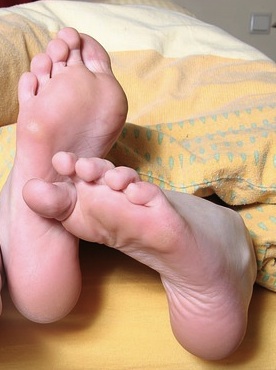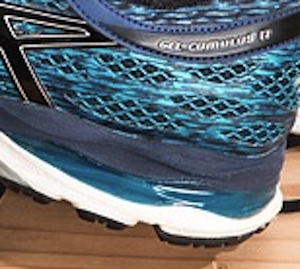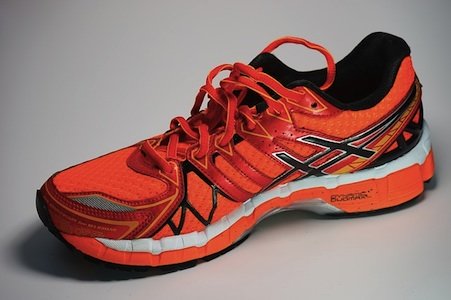

Can the Right Athletic Shoes Help with Plantar Fasciitis?
If you’ve ever felt a stabbing pain on the bottom of your foot when you stepped out of bed in the morning, you may have plantar fasciitis. It can happen to runners and people who are on their feet all day, but it can also happen to more sedentary folks. It happened to me after my pregnancy, most likely due to changes in my feet when my weight changed.
I can attest that this condition is very painful, but I didn’t want to stay off my feet while waiting for it to heal. If you’re suffering from this ailment and looking for a way to stay comfortable while remaining active, can your choice of athletic shoes really make a difference?
What is Plantar Fasciitis?
Plantar fasciitis is an inflammation on the bottom of your foot that causes pain in your heel and/or your arch. The band of connective tissue – called plantar fascia – that runs from your toes, across the arch of your foot, and attaches to your heel bone becomes inflamed and painful.
With plantar fasciitis, the pain usually occurs first thing in the morning when you get out of bed. Once you get up and walk around a bit, the pain will decrease. But it may come back again if you stand for a long time or sit for awhile and then get up to walk around again.

What Causes Plantar Fasciitis?
Some causes of plantar fasciitis include injuries to your foot, wearing shoes without enough support, or using improper foot mechanics while running or walking. If you overpronate, your foot turns in excessively when walking or running. This action causes your foot to flatten, which lengthens your arch, resulting in added tension in the plantar fascia tissue. Repeating this action over time may lead to small tears and inflammation, and eventually to the pain of plantar fasciitis.
The cause of individual cases of plantar fasciitis is not always clear, but there are certain risk factors and circumstances (outlined by the Mayo Clinic) that can increase the likelihood of getting it. These include…
- Age – Plantar fasciitis occurs more often in people between the ages of 40 and 60.
- Specific Exercises – Long-distance running, jumping, ballet dancing, aerobics, and similar activities can put a lot of stress on your heels.
- Foot Mechanics – Flat feet, high arches, or an abnormal walking pattern can affect the way your weight is distributed and put additional stress on your plantar fascia.
- Obesity – Extra weight obviously puts more stress on your feet.
- Standing for Long Periods – Jobs or activities that require you to be on your feet for hours at a time, especially on harder surfaces, can damage your foot tissue.
Athletic Shoes for Plantar Fasciitis
The pain of plantar fasciitis tends to be worse after exercising, not during it. But if you’re an active person who is suffering from this pain, you’re probably looking for a way to continue your regular activities without making the problem worse. Your choice of athletic shoes is important for your comfort and to prevent any further injuries.
There are many athletic shoes out there that claim to help with plantar fasciitis, and some that even say they are designed specifically to deal with it. But the only way to be sure if the shoe is right or helpful to you is to try it yourself.
That being said, here are some important things you should look for in athletic shoes if you’re dealing with plantar fasciitis or trying to avoid it…
- Padding and shock absorption
- Good arch support
- Motion control shoes that prevent the inward rolling, or overpronation, of your foot
- Heel cushioning, for example those that include gel
- Strong materials to support your foot rather than canvas or cheap leathers that are too flexible and soft to provide stability and support
- Shoes with removable insoles that can be replaced with special insoles that fit your foot better or with customized orthotics if necessary

Wearing the proper athletic shoes to support your feet can help keep your feet in their natural position. This will help you maintain a normal gait, preventing not only plantar fasciitis, but also potential wear to your knees, hips, and lower back.
What Can You Do About Plantar Fasciitis?
Leaving plantar fasciitis untreated obviously means you will continue to be in pain. The pain may cause you to change your daily activities or even change the way you walk, which could lead to further complications in your feet, knees, hips, or back.
You may decide to consult your family doctor or a podiatrist, and they will most likely suggest conservative treatment measures. These include applying ice to your feet, doing specific foot exercises, stretching your foot muscles, and taking anti-inflammatory medication.
If these measures don’t alleviate your pain, your doctor may suggest physical therapy or custom orthotic devices that will correct the position of your feet to eliminate the cause of your pain.

In addition to wearing proper athletic shoes, here are some other specific measures you can try to help overcome or eliminate plantar fasciitis:
- Wear supportive shoes for athletic activities as well as everyday wear. Don’t go barefoot or wear high heels.
- Don’t wear worn-out athletic shoes. Replace them when they no longer support and cushion your feet.
- Try a lower impact sport if running or walking causes your foot problems. Biking, swimming, or water aerobics put much less stress on your feet.
- If you are a runner or walker and you don’t want to stop, try exercising on softer surfaces such as running tracks, grass, or gravel paths rather than concrete.
- If you are going to increase or change your workout, do so gradually. A drastic change in a short time period can increase the amount of stress on your feet.
If you have plantar fasciitis, I hope this page is helpful to you. For more tips and information, you may want to visit my pages about what physical therapists and podiatrists have to say about athletic shoes.
If you have any advice about athletic shoes for plantar fasciitis, please share it by sending me a message through the form at the bottom of this page, or by sharing your shoe story on my Shoe Reviews page.
